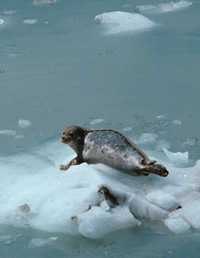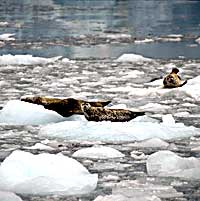



|
Harbor Seal - Phoca Vitulina Basic Facts  The harbor seal is a member of the family Phocidae or “true earless or hair seals.” Only a wrinkling or opening in the skin denotes external ears. The first sighting in the water is usually of the round head. The fore flippers are small and placed far forward with five long, clawed digits. The longer hind flippers are used for locomotion under water but cannot be turned forward as with sea lions. Harbor seals wriggle and hunch to travel on land. Because this is laborious, they will roll or slide whenever possible. The average adult found in Alaska waters is just over five feet in length and weighs about 190 pounds. Harbor seals in Atlantic waters are significantly smaller than those in Alaska or the Western Pacific, averaging five feet long and 185 pounds. The harbor seal is a member of the family Phocidae or “true earless or hair seals.” Only a wrinkling or opening in the skin denotes external ears. The first sighting in the water is usually of the round head. The fore flippers are small and placed far forward with five long, clawed digits. The longer hind flippers are used for locomotion under water but cannot be turned forward as with sea lions. Harbor seals wriggle and hunch to travel on land. Because this is laborious, they will roll or slide whenever possible. The average adult found in Alaska waters is just over five feet in length and weighs about 190 pounds. Harbor seals in Atlantic waters are significantly smaller than those in Alaska or the Western Pacific, averaging five feet long and 185 pounds.Harbor seals have various haul-outs in Kenai Fjords National Park both on boulders near shore at high tide and on ice flows in front of tidewater glaciers. They are seen more often out of the water during pupping season in June and later during their fall molt, August through September. Their color varies from silver white to almost black with contrasting colored spots, rings, or blotches. In our local waters the “light” phase is more common. Pups are generally born with spotted silver coats but occasionally show a longer, softer white or gray coat (lanugo) that sheds usually within 10 days.  Harbor seals are known to have lived to over 30 years of age. The average for females in the wild is around 25-30 years. Males are usually shorter lived, partly due to the stress of fighting during the breeding season. Harbor seals are known to have lived to over 30 years of age. The average for females in the wild is around 25-30 years. Males are usually shorter lived, partly due to the stress of fighting during the breeding season.Transient orcas and large sharks, including the salmon and sixgill, feed on harbor seals, especially pups. Diseases such as distemper, influenza, heartworm, and bacterial infections, as well as gut nematodes, take their toll on the population. In 1999, the worldwide population was estimated at around half a million. During the 1980s, numbers declined 63-85 percent in Alaska. Locally, the seals in Aialik Bay near Aialik Glacier have decreased from more than 1,600 to about 200 seals. This decline coincides with a widespread decline of sea lions, marine birds, and other marine species throughout the Gulf of Alaska. Recently, harbor seal numbers are climbing again. In the park, the numbers are at about 50 percent of the original population of the 1980s. Habitat, Range and Local Sightings Pacific harbor seals are found in the temperate and subarctic coastal waters extending from Mexico to the Bering Sea to Hokkaido, Japan. In general, the harbor seal is non-migratory, making limited movements due to foraging and breeding. One exception is young seals that have been known to disperse up to 150 miles. Around Kenai Fjords they inhabit rocky shores, beaches, and ice. Thumb Cove and Humpy Cove on the east side of Resurrection Bay offer occasional sightings of harbor seals, generally in the water. There are haul-out areas on the northwest sides of both Hive Island and Rugged Island. Even better viewing is experienced in either Porcupine Cove or Spire Cove on the west side south of Bear Glacier. Further out in Aialik Bay, Aialik Glacier gives the most consistent viewing of harbor seals as they use the ice in front of the glacier as haul-out, pupping, and fishing platforms. Food and Survival Strategies Pacific harbor seals are opportunistic, eating a variety of schooling fish, bottom fish, crustaceans, and squid. They consume up to eight percent of their body weight in food per day. The ice flows from the tidewater glaciers and sharp drop-offs from rocky shores of the surrounding fjords offer access to various prey items and refuge from predation by marine predators. Low profile on the water makes them less visible to terrestrial predators. Reproduction and Young  Pacific harbor seals are sexually mature at three to five years of age. In Alaska, they breed in July through August. After a 10-month gestation period, females give birth in June to a single pup. Three to four weeks later, after the pup is weaned, mating takes place. Pacific harbor seals are sexually mature at three to five years of age. In Alaska, they breed in July through August. After a 10-month gestation period, females give birth in June to a single pup. Three to four weeks later, after the pup is weaned, mating takes place.Harbor seal pups weigh about 25 pounds at birth and are ready to enter the water almost immediately. Pups gain about one-and- a-half pounds a day on the rich milk and usually weigh 55 to 66 pounds when weaned. Females recognize and find their own pup both on land and in the water by vocalizations unique to that pair. A few weeks before weaning, the pup often rides on its mother’s back as she dives and swims. After the pup is weaned, the mother promptly abandons it. Although individuals come together at haul-out and breeding sites, harbor seals are generally solitary by nature with no social cohesion other than the mother-pup bond during lactation. When groups of seals are together, there is usually agonistic behavior such as biting, head butting, flipper waving, and snorting. Human Connections Alaska Natives are allowed a subsistence harvest of approximately 2,700 per year for meat, blubber, and hide. Harbor seals are an indicator species and are known to carry accumulated pollutants in blubber. More general information on Kenai Fjords National Park is available at: Kenai Fjords National Park We would like to thank the NPS for the above information. |




